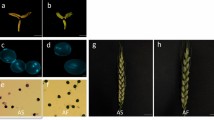Abstract
A previously reported cytoplasmic male sterility-associated fragment was detected in chili pepper (Capsicum annuum L.) and sequenced in the mitochondria of a sterile plant. This fragment, 16 kb in size, contains two common mitochondrial genes, coxII and atp6-2, and the newly detected gene orf456, which appears to be a strong candidate gene for the male sterile phenotype. The data show that one nucleotide (Cytosine) at the +449 position is missing compared with the original sequence data of orf456. By translation to the amino acid sequence, the termination codon was found 49 nt downstream from the original site. This hypothetical extension was confirmed by RT-PCR, which showed a sequence size of 507 bp. Since pollen fertility can be restored by a nuclear restorer of fertility gene (Rf), the transcription of orf507 was checked in four stages of flower development. The RT-PCR resulted in a fragment in stage III in the restorer line, indicating a possible role in microspore development.






Similar content being viewed by others
References
Bellaoui M, Martin-Canadell A, Pelletier G, Budar F (1998) Low-copy-number molecules are produced by recombination, actively maintained and can be amplified in the mitochondrial genome of Brassicaceae: relationship to reversion of the male sterile phenotype in some cybrids. Mol Gen Genet 257:177–185
Engelke T, Hulsmann S, Tatlioglu T (2002) A comparative study of microsporogenesis and anther wall development in different types of genic and cytoplasmic male sterilities in chives. Plant Breeding 121:254–258
Gray MW, Covello PS (1993) RNA editing in plant mitochondria and chloroplasts. The FASEB J 7:64–71
Gulyas G, Pakozdi K, Lee JS, Hirata Y (2006) Analysis of fertility restoration by using cytoplasmic male sterile red pepper (Capsicum annuum L.) lines. Breeding Sci 56:331–334
Hanson MR (1991) Plant mitochondrial mutations and male sterility. Annu Rev Genet 25:461–486
Hanson M, Bentolila S (2004) Interactions of mitochondrial and nuclear genes that affect male gametophyte development. Plant Cell 16:S154–S169
Hirose T, Fujime Y (1981) Studies on the hybrid seed production by using a new male sterile line in pepper (Capsicum annuum L.). II. On the process of pollen degeneration. J Jpn Soc Hortic Sci 50:66–70
Hodges P, Scott J (1992) Apolipoprotein B mRNA editing: a new tier for the control of gene expression. Trends Biochem Sci 17:77–81
Horner HT Jr, Rogers MA (1974) A comparative light and electron microscopic study of microsporogenesis in male-fertile and cytoplasmic male sterile pepper (Capsicum annuum). Can J Bot 52:435–441
Kim DH, Kim BD (2006) The organization of mitochondrial atp6 gene region in male fertile and CMS lines of pepper (Capsicum annuum L.). Curr Genet 49:59–67
Kim DH, Kang JG, Kim S, Kim BD (2001) Identification of coxII and atp6 regions as associated to CMS in Capsicum annuum by using RFLP and long accurate PCR. J Kor Soc Hort Sci 42:121–127
Kim DH, Kang JG, Kim BD (2007) Isolation and characterization of the cytoplasmic male sterility-associated orf456 gene of chili pepper (Capsicum annuum L.). Plant Mol Biol 63:519–532
Lu R, Martın-Hernandez AM, Peart JR, Malcuit I, Baulcombe DC (2003) Virus-induced gene silencing in plants. Methods 30:296–303
Martin J, Grawford JH (1951) Several types of sterility in Capsicum frutescens. Proc Am Soc Hortic Sci 57:335–338
Novak F, Betlach J, Dubovsky J (1971) Cytoplasmic male sterility in sweet pepper (Capsicum annuum L.). I. Phenotype and inheritance of male sterile character. Z Pflanzenzucht 65:129–140
Peterson PA (1958) Cytoplasmically inherited male sterile in Capsicum. Am Nat 92:111–119
Schnable PS, Wise RP (1998) The molecular basis of cytoplasmic male sterility and fertility restoration. Trends Plant Sci 3:175–180
Walbot V, Warren C (1988) Regulation of Mu element copy number in maize line with an active or inactive mutator transposable element system. Mol Gen Genet 211:27–34
Wang LH, Zhang BX, Lefebvre V, Huang SW, Daubkze AM, Palloix A (2004) QTL analysis of restoration in cytoplasmic male sterile pepper. Theor Applied Genet 109:1058–1063
Zhong L, Batt DB, Carmichael GG (1994) An improved rapid method of isolating RNA from cultured cells by SDS-acid phenol/chloroform extraction. Biotechniques 16:56–57
Acknowledgement
The authors thank Dr. Hidenori Sassa for his help in cloning the CMS-associated 16 kb fragment.
Author information
Authors and Affiliations
Corresponding author
Rights and permissions
About this article
Cite this article
Gulyas, G., Shin, Y., Kim, H. et al. Altered Transcript Reveals an Orf507 Sterility-Related Gene in Chili Pepper (Capsicum annuum L.). Plant Mol Biol Rep 28, 605–612 (2010). https://doi.org/10.1007/s11105-010-0182-4
Published:
Issue Date:
DOI: https://doi.org/10.1007/s11105-010-0182-4




